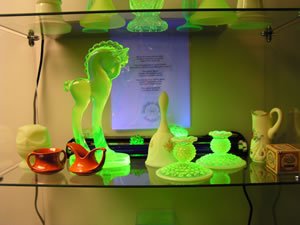TENORM: Consumer Products
Some technologically enhanced naturally occurring radioactive material (TENORM) may be found in certain consumer products. For example, at one time, uraniumA heavy, naturally radioactive, metallic element that is used to produce nuclear power. was used as a glaze for ceramics. Some common building materials such as granite countertops contain naturally occurring radioactive materials (NORM). Cigarettes are the most widely available consumer product that contains TENORM (polonium A radioactive element that occurs in pitchblende and other uranium-containing ores.-210).
On this page:
Antiques

Among the furniture, clothing, jewelry, books, dolls, dishes, and many other objects sold at flea markets and antique shops, you will likely find items that contain radioactive compounds. These items were generally made and originally sold before the health effects of radiation were well understood and long before radiation protection regulations were put in place. "Vaseline" glass contains small amounts of uranium, which causes the glass to glow under black lights, as shown in the photo to the right. Uranium was also used as a glaze for Fiestaware, which was popular in the 1960s. Read more about radioactive materials in antiques.
Building Materials
Nearly all rocks, minerals, and soil may contain small amounts of naturally occurring radioactive materialsMaterials found in nature that emit ionizing radiation that have not been moved or concentrated by human activity.. When these soils or rocks are incorporated into building materials, the naturally occurring radioactive elements are included as well. Radioactive materials may be found in common building products such as red brick, fire brick, cement, cinder blocks, granite countertops, and glazed tiles. Additionally, fly ash or phosphogypsum containing small amounts of TENORM, may be used as a soil amendment in agriculture. Fly ash may also be used as admixture in road base, cement and other construction materials. Radionuclides found in these materials include potassium, radium, thorium and uranium. Learn more about granite countertops and radiation.
Tobacco Products
One of the largest radiation doses received by the public (after radon) is from smoking cigarettes. Tobacco plants can uptake radioactive elements present in soil through their roots, and long-lived radon decay products in the air can stick to tobacco leaves. When tobacco leaves are later processed into cigarettes and other products, the radioactive elements remain. While tobacco products are not an obvious source of radiation exposure, they contain small amounts of radioactive elements that smokers bring into their bodies as they inhale or otherwise consume the tobacco. Radioactivity may be one of the key factors in lung cancer among smokers. Read more about radionuclides in tobacco smoke.
